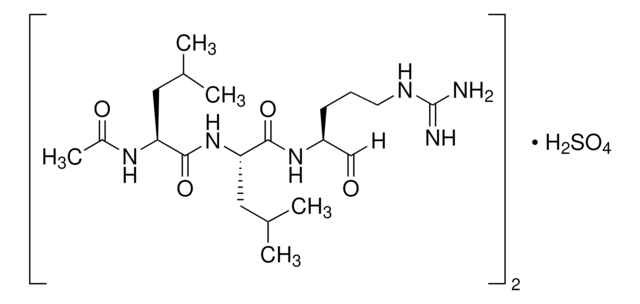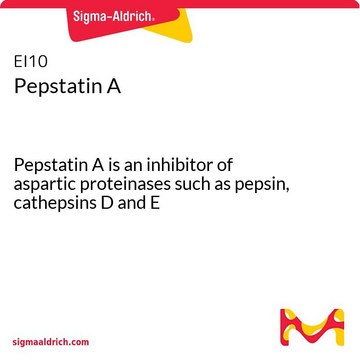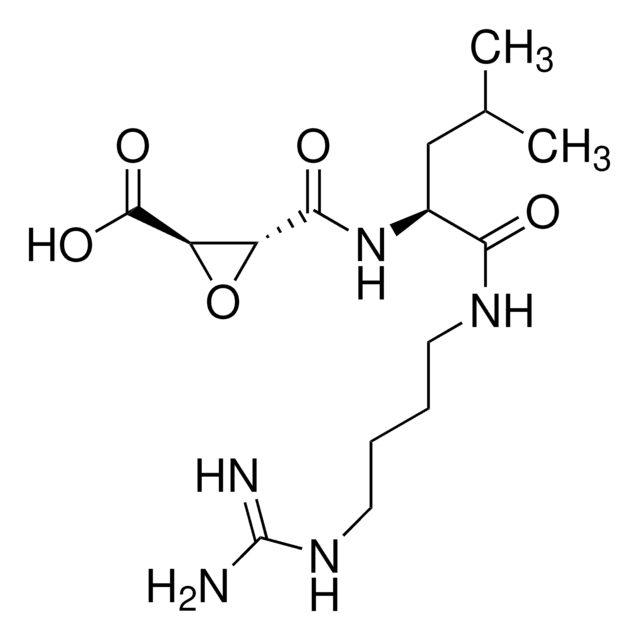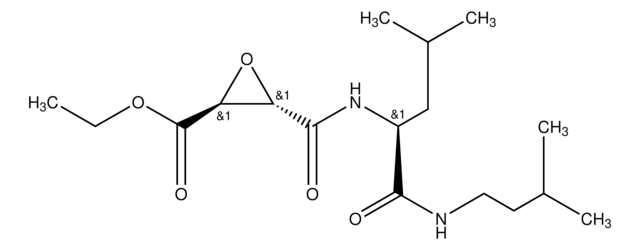Select a Size
CN¥6,780.43
Available to ship onApril 27, 2025Details
Select a Size
About This Item
CN¥6,780.43
Available to ship onApril 27, 2025Details
Recommended Products
Product Name
Pepstatin A, microbial, ≥90% (HPLC)
biological source
microbial
Quality Level
Assay
≥90% (HPLC)
form
powder
mp
233 °C (dec.) (lit.)
solubility
ethanol: 1-2 mg/mL (with heat up to 60 °C)
storage temp.
2-8°C
SMILES string
CC(C)C[C@H](NC(=O)[C@H](C)NC(=O)C[C@H](O)[C@H](CC(C)C)NC(=O)[C@@H](NC(=O)[C@@H](NC(=O)CC(C)C)C(C)C)C(C)C)[C@@H](O)CC(O)=O
InChI
1S/C34H63N5O9/c1-17(2)12-23(37-33(47)31(21(9)10)39-34(48)30(20(7)8)38-27(42)14-19(5)6)25(40)15-28(43)35-22(11)32(46)36-24(13-18(3)4)26(41)16-29(44)45/h17-26,30-31,40-41H,12-16H2,1-11H3,(H,35,43)(H,36,46)(H,37,47)(H,38,42)(H,39,48)(H,44,45)/t22-,23-,24-,25-,26-,30-,31-/m0/s1
Looking for similar products? Visit Product Comparison Guide
1 of 4
This Item | P4265 | 77170 | PEPSRO |
|---|---|---|---|
| assay ≥90% (HPLC) | assay ≥75% (HPLC) | assay - | assay - |
| biological source microbial | biological source microbial | biological source Streptomyces sp. | biological source synthetic |
| Quality Level 200 | Quality Level 300 | Quality Level 100 | Quality Level 100 |
| form powder | form powder | form powder | form lyophilized |
| solubility ethanol: 1-2 mg/mL (with heat up to 60 °C) | solubility ethanol: acetic acid (9:1): 1 mg/mL, clear to hazy, colorless | solubility ethanol: soluble 1 mg/mL | solubility ethanol: 1 mg/mL, methanol: 1 mg/mL, acetic acid: soluble 300 μg/mL (6N), pyridine: soluble, water: insoluble |
| storage temp. 2-8°C | storage temp. 2-8°C | storage temp. 2-8°C | storage temp. 2-8°C |
General description
Application
Biochem/physiol Actions
Preparation Note
Stock solutions at 1 mg/ml are stable at least a week at 4 °C. A 1 mM solution in methanol or DMSO is stable for months at -20 °C. If solutions become darker yellow, the reagent is hydrolyzing.
A working concentration of 1 μM is stable for at least one day at room temperature.
Storage Class Code
11 - Combustible Solids
WGK
WGK 2
Flash Point(F)
Not applicable
Flash Point(C)
Not applicable
Personal Protective Equipment
Regulatory Information
Choose from one of the most recent versions:
Certificates of Analysis (COA)
Don't see the Right Version?
If you require a particular version, you can look up a specific certificate by the Lot or Batch number.
Already Own This Product?
Find documentation for the products that you have recently purchased in the Document Library.
Articles
ReadyShield® phosphatase and protease inhibitor cocktail FAQ for sample protection in a variety of cell types and tissue extracts, including mammalian, plant, and microbial samples. Our ReadyShield® Protease Inhibitor Cocktail is a non-freezing solution that contains inhibitors with a broad specificity for serine, cysteine, acid proteases and aminopeptidases.
Our team of scientists has experience in all areas of research including Life Science, Material Science, Chemical Synthesis, Chromatography, Analytical and many others.
Contact Technical Service





